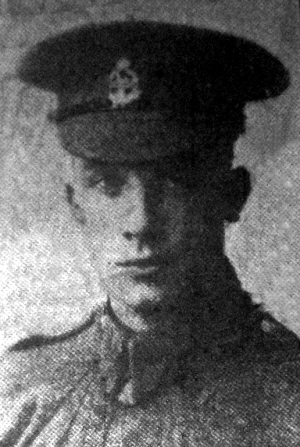
Ernest Firth was born in Ossett on the 30th October 1895 and was baptised at the Wesleyan Methodist Chapel, Wesley Street, Ossett on the 8th December 1895, the second child and only son of Ossett-born Joseph Senior Firth and his wife, Suffolk-born Ellen (nee Garrard), who married in 1890 in Ossett.
In 1901 Joseph, a clerk for a mungo manufacturer, wife Ellen and their two children were living on Westfield Street, Ossett. By 1911, both Joseph and his 15 year-old, son Ernest, were working as commercial clerks for a rag merchant, whilst Ernest’s elder sister, Hilda Firth, aged 16, was a milliner’s apprentice. The family were still living on Westfield Street, Ossett and the couple now have three children with the addition of a two month-old girl, Jessie Firth.
Ernest Firth was living and working at Haslingden in Lancashire in 1916 and he enlisted there in January 1916 when he joined the East Lancashire Regiment with service number 24189. He was later transferred to the 19th Battalion of the King’s (Liverpool) Regiment.
The 19th (Service) Battalion (3rd City) of the King’s (Liverpool) Regiment was formed in Liverpool on the 29 August 1914 by Lord Derby, in the old watch factory at Prescot. On the 30 April 1915, the battalion came under orders of 89th Brigade, 30th Division and landed at Boulogne in November 1915. On the 14th May 1918 it was reduced to cadre strength and on the 19 June 1918, the battalion was attached to 66th (2nd East Lancashire) Division and absorbed by 14th Battalion.
Ernest Firth was most probably wounded in the Battle of the Scherpenberg on the 29th April 1918, which involved a final German attack by the Germans to capture the Scherpenberg, a hill to the north-west of the Kemmelberg. The 89th Infantry Brigade of the 30th Division took part in the Battle of the Scherpenberg on the 29th April, the last phase of the Battles of the Lys and suffered very heavy casualties.
During WW1, Scherpenberg was regarded as a strategically important position by the attacking Germans, and is located to the north-west of Kemmel Hill and south-west of Ypres.
The “Ossett Observer” 1 had this obituary for Ernest Firth:
“Young Ossett Soldier’s Sacrifice – Following a rather hopeful letter on Saturday from an Australian clearing station in France, concerning their only son, Lance-corporal Ernest Firth (22), King’s Liverpool Regiment, who was wounded in recent fighting, Mr. and Mrs. Joseph S. Firth, of Westfield-street, Ossett, on Monday received the distressing news that the young soldier had succumbed to his injuries. An army chaplain, in the course of a sympathetic letter, said that gangrene developed from a shrapnel wound in the leg, so that it became necessary to amputate the limb. At mid-day on the previous Wednesday, the patient was wonderfully bright and cheery, and hopes were entertained of his making a good recovery, but during the afternoon he suddenly collapsed and died. The writer added that he remained brave and cheery to the end, and had been buried in a little cemetery near the clearing station.
Lance-corporal Firth, who used to be in the borough treasurer’s department at the Ossett Town Hall, had obtained an appointment in the treasurer’s department at Haslingden, Lancashire where he was giving much promise, when he enlisted in the East Lancashire Regiment, in January 1916. A few months later he formed part of a draft of men for India, but was retained in England to undergo a course of special training in musketry, and continued until September 1917, as a musketry instructor. Then he qualified form and became a Lewis-gun instructor, and was transferred to the King’s Liverpool Regiment on going to France, which was so recently as March 17th last. Until he left Ossett deceased was actively connected with the Wesley-street, Wesleyan Sunday School, being the harmoniumist for years and he afterwards identified himself with religious work at Haslingden.”

Above: Scherpenberg Hill, the scene of the Battle of Scherpenberg in April 1918
Ernest Firth’s army service record has not survived, but he was posthumously awarded the British and Victory medals. He did not serve overseas before 31st December 1915.
Lance-Corporal Ernest Firth, died of wounds on the 1st May 1918, aged 22 years, the son of Joseph Senior Firth and Ellen Firth, of “Westleigh,” Westfield Street, Ossett. He is buried at grave reference V. A. 81. at the Longuenesse (St. Omer) Souvenir Cemetery,2 Pas de Calais, France. St. Omer is a large town 45 kilometres south-east of Calais. Longuenesse is a commune on the southern outskirts of St. Omer. The Cemetery is approximately 3 kilometres from St Omer, beside the Wizernes (Abbeville) road (the D928), at its junction with the Rue des Bruyeres. There is a large car park to the rear of the cemetery.
St. Omer was the General Headquarters of the British Expeditionary Force from October 1914 to March 1916. Lord Roberts died there in November 1914. The town was a considerable hospital centre with the 4th, 10th, 7th Canadian, 9th Canadian and New Zealand Stationary Hospitals, the 7th, 58th (Scottish) and 59th (Northern) General Hospitals, and the 17th, 18th and 1st and 2nd Australian Casualty Clearing Stations all stationed there at some time during the war. St. Omer suffered air raids in November 1917 and May 1918, with serious loss of life.
The cemetery takes its names from the triangular cemetery of the St. Omer garrison, properly called the Souvenir Cemetery (Cimetiere du Souvenir Francais) which is located next to the War Cemetery.
The Commonwealth section of the cemetery contains 2,874 Commonwealth burials of the First World War (6 unidentified), with special memorials commemorating 23 men of the Chinese Labour Corps whose graves could not be exactly located. Second World War burials number 403, (93 unidentified). Within the Commonwealth section there are also 34 non-war burials and 239 war graves of other nationalities.
References:
1. “Ossett Observer”, 11th May 1918